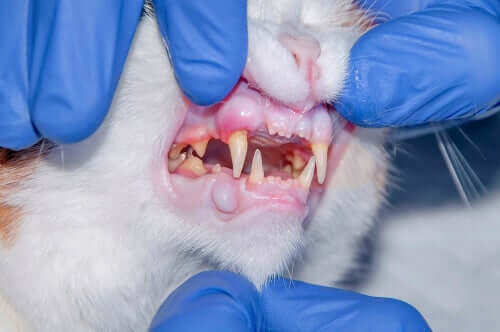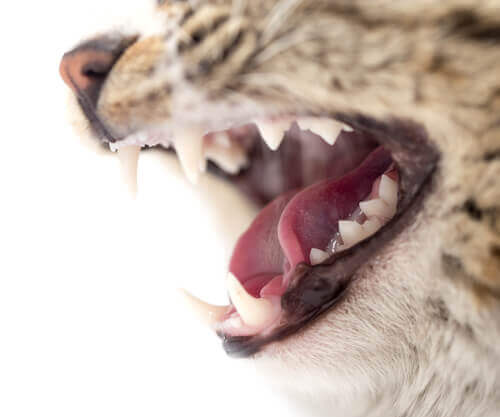Feline Teeth - What You Should Know about Them


Written and verified by biochemistry Luz Eduviges Thomas-Romero
The health of feline teeth is important because they use them to perform all sorts of activities like eating, hunting, biting toys, etc. As animals grow older, their risk of developing various forms of dental diseases increases.
What do you know about feline teeth?
Like humans, cats have two sets of dentures in their lives. The first one comprises of 26 “milk” teeth. They appear around the third week of life and are usually very sharp, almost needle-like. The cats lose them around the age of four months.
Likewise, their permanent denture has 30 teeth. It contains highly-developed fangs that are similar to human incisors.
In addition, the shape of their molars is also rather characteristic of this animal. Their purpose is to tear and cut their food, not to chew it as we do with our human molars.
Feline teeth are made of the same bone material as the rest of their bodies. The dentin and the enamel cover the crown and the cementum covers the root. Likewise, there are the soft tissues of the tooth, which include the pulp with its blood vessels, nerves, and connective tissue.
When a cat has an oral condition, it’s usually due to one of four causes: periodontal disease, oral cancer, feline stomatitis or root resorption. This latter is the most common among these.

What characterizes root resorption?
Generally, in a process of resorption, the original structure gradually blurs until it’s gone entirely. Thus, there’s a gradual destruction of the cat’s teeth when there’s root resorption. The process is extremely painful but many cats don’t show any obvious signs of pain unless you touch a soft spot.
The process begins on the outside of a tooth, on the gum line. Even though this condition can occur in any tooth, it’s a lot more common in the premolars of their lower jaw. Externally, it may look as if the gum tissue is growing on or inside a tooth.
It may also seem like there’s a hole in the tooth, which is why tooth resorption is sometimes mistaken for a cavity. In fact, cavities are quite rare in cats.
In the final stages of the process, the enamel reabsorbs and the tooth fractures or the gum line visibly changes shape – with hard tissue that’s similar to bone tissue.

Possible causes of resorption in feline teeth
We know that the plaque that accumulates on the surface of the tooth causes an inflammatory reaction. And it also plays a role in the development of root resorption.
So, although there are no conclusive studies, scientists suggest that chronic excess of vitamin D in their diet may be the cause of root resorption in domestic cats. This is because some industrial cat foods contain higher levels of vitamin D than the recommended amounts.
Treatment of resorption
The removal of a tooth under resorption is the only treatment for this condition. Extraction can be a difficult procedure to perform because the affected teeth are usually quite fragile. In fact, they often fracture and splinter during an extraction.
So, you must keep in mind that the vet will need to take some x-rays to confirm a diagnosis. And also for visualizing fragments of the fractured teeth. They must extract the entire tooth and all of its fragments to avoid infections or other problems.
Not all veterinary clinics can deal with a case of root resorption. So, dental x-rays and adequate surgical augmentation equipment are necessary, as well as an adequately trained vet.
All cited sources were thoroughly reviewed by our team to ensure their quality, reliability, currency, and validity. The bibliography of this article was considered reliable and of academic or scientific accuracy.
- Reiter, A. M., Lewis, J. R., & Okuda, A. (2005). Update on the etiology of tooth resorption in domestic cats. Veterinary Clinics: Small Animal Practice, 35(4), 913-942.
- Reiter A, Lyon K, Nachreiner R, Shofer F. (2005) Evaluation of calciotropic hormones in cats with odontoclastic resorptive lesions. AJVR; 66: 1446-1452.
- Vogt, A. H., Rodan, I., Brown, M., Brown, S., Buffington, C. T., Forman, M. L., … & Sparkes, A. (2010). AAFP-AAHA: feline life stage guidelines.
- Booij-Vrieling H, de Vries T., Schoenmaker T, Tryfonidou M, Penning L, Hazewinkel H, Everts V. (2012). Osteoclast progenitors from cats with and without tooth resorption respond differently to 1, 25-dihydroxyvitamin D and interleukin-6. Research in veterinary science, 92(2), 311-316.
This text is provided for informational purposes only and does not replace consultation with a professional. If in doubt, consult your specialist.